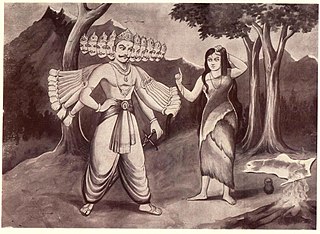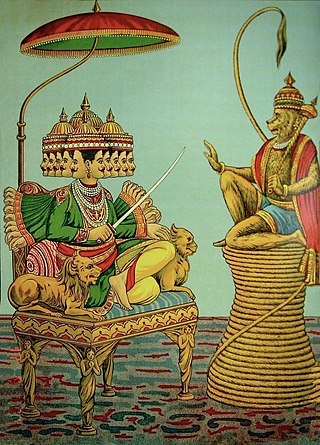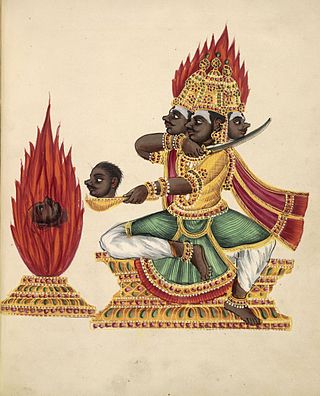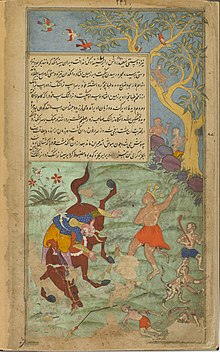
Ravana is a multi-headed rakshasa (demon) king of the island of Lanka, and the chief antagonist in the Hindu epic Ramayana. In the Ramayana, Ravana is described as the eldest son of sage Vishrava and Kaikesi. He abducted Prince Rama's wife, Sita, and took her to his kingdom of Lanka, where he held her in the Ashoka Vatika. Rama, with the support of vanara King Sugriva and his army of vanaras, launched an invasion against Ravana in Lanka. Ravana was subsequently slain, and Rama rescued his beloved wife Sita.

Lakshmana (Sanskrit: लक्ष्मण, romanized: Lakṣmaṇa, lit. 'the fortunate one'), also spelled as Laxmana(Lakhan), is the younger brother of Rama and his loyalist in the Hindu epic Ramayana. He bears the epithets of Saumitra (Sanskrit: सौमित्र, romanized: Saumitra, lit. 'son of Sumitra') and Ramanuja (Sanskrit: रामानुज, romanized: Rāmānuja, lit. 'younger brother of Rama'). He is the twin of Shatrughna.

Chiranjivi are the eight or nine immortals who are to remain alive on Earth until the end of the current Kali Yuga, according to Hinduism. The Sanskrit term Chiranjivi means “immortal”, even though it does not correspond with “eternal”. The term is a combination of "chiram" (forever) and jivi (lived).

In Hinduism, Vanara are either monkeys, apes, or a race of forest-dwelling people.

Meghanada, also referred to by his epithet Indrajitalit. 'conqueror of Indra', according to Hindu texts, was a son of Ravana and the crown prince of Lanka, who conquered Indraloka (Heaven). He is regarded as one of the greatest warriors in Hindu texts. He is a major character mentioned in the Indian epic Ramayana. Meghnada is the central character in Bengali ballad Meghnad Badh Kavya. He played an active role in the great war between Rama and Ravana. He acquired many kinds of celestial weapons from his Guru Shukra. His most prominent feat is having defeated the devas in heaven. Using the Brahmastra, Indrajita killed 670 million vanaras in a single day; nearly exterminating the entirety of the vanara race. No warrior had ever achieved this statistical feat before in the Ramayana. He is the only warrior in the entire Ramayana to defeat both Rama and Lakshmana twice while they were both armed by making them unconscious in a battle with the help of astras and sorcery. He was said to be more powerful and superior warrior than his father Ravana by Lord Brahma and Agastya. He is the only warrior in the entire Hindu text to possess all three "Trimurti astras", namely, Brahmastra, Vaishnavastra, and Pashupatastra.

Jatayu is a demigod in the Hindu epic Ramayana, who has the form of either an eagle or a vulture. He is the younger son of Aruṇa and his wife Shyeni, the brother of Sampati, as well as the nephew of Garuda. He is also an old friend of King Dasharatha, Rama's father.

The Shiva Tandava Stotra(m) (Sanskrit: शिवताण्डवस्तोत्र, romanized: śiva-tāṇḍava-stotra) is a Sanskrit religious hymn (stotra) dedicated to the Hindu deity, Shiva, one of the principal gods in Hinduism and the supreme god in Shaivism. Its authorship is traditionally attributed to the mythical demon (rakshasa) Ravana, the ruler of Lanka, considered a devotee of Shiva.

Vedavati is the previous birth of the goddess Sita in Hindu mythology. She is an avatar of the goddess of prosperity, Lakshmi.
In the Hindu epic, the Ramayana, Prahasta was a powerful rakshasa warrior and the chief commander of Ravana's army of Lanka. He was the son of Sumali and Ketumathi. In his next birth, Prahasta was reborn as Purochana in the Mahabharata as Duryodhana's trusted aide and was the main responsible for the Lakshagraha incident.

Adhyatma Ramayana is a 13th- to 15th-century Sanskrit text that allegorically interprets the story of Hindu epic Ramayana in the Advaita Vedanta framework. It is embedded in the latter portion of Brahmānda Purana, and the author is considered to be Vyasa. The Hindu tradition also attributes the text to the Bhakti movement saint Ramananda.

Shurpanakha, is a rakshasi (demoness) in Hindu epic. Her legends are mainly narrated in the epic Ramayana and its other versions. She was the sister of Lanka's king, Ravana, and the daughter of the sage Vishrava and the rakshasi Kaikeshi. Shurpanakha's role in the original epic is small, yet significant.

Angada is a legendary vanara in Hinduism. He helps Rama find his wife Sita and fight her abductor, Ravana, in the epic Ramayana. He is the prince of Kishkindha, and is later crowned as the kingdom's monarch.

Trishira is a rakshasa featured in the Ramayana. He is one of the sons of Ravana and Dhanyamalini and his brothers are Atikaya, Narantaka and Devantaka.

Dandakaranya is a historical region in India, mentioned in the Ramayana. It covers about 92,200 square kilometres (35,600 sq mi) of land, which includes the Abujhmar Hills in the west and the Eastern Ghats in the east, including regions of Andhra Pradesh, Maharashtra, Chhattisgarh, Odisha, Telangana and Karnataka states. It spans about 300 kilometres (200 mi) from north to south and about 500 kilometres (300 mi) from east to west. Dandakaranya roughly translates from Sanskrit to "The Jungle (aranya) of Danda ."

Bala Kanda is the first book of the Valmiki Ramayana, which is one of the two great epics of India. There has been debate as to whether Bala Kanda was composed by the original author Valmiki or a later addition.
In the Hindu epic Mahabharata, the Upapandavas, also known as Pandavaputras, Draupadeyas or Panchakumaras are the five sons of Queen Draupadi from each of the five Pandavas. They are Prativindhya, Sutasoma, Shrutakarma, Shatanika and Shrutasena. They were Atirathis, as mentioned by Bhishma, and fought the Kurukshetra war on the side of the Pandavas and slew many enemy warriors. They were as ferocious as their fathers but other than that, not much is said in the Mahabharata about the brothers. They were very strong and they were only defeated by remarkably few Kaurava warriors.

In the Hindu epic Ramayana, Nala, is the vanara (monkey), who is credited as the engineer of the Rama Setu, a bridge across the ocean between Rameswaram and Lanka, identified with modern-day Sri Lanka, so forces of the god Rama can pass over to Lanka. The bridge is also known as Nala Setu, the bridge of Nala. Along with Nala, another vanara who is his twin brother called Nila is also credited as the builder of the bridge. Nala is described as the architect of the vanaras. He is described as the son of the architect-god Vishwakarma. Nala is also described to have fought in the battle between Rama and Ravana, the king of Lanka.

Dhanyamalini, also referred to as Dhanyamala and Dhanyamali, is the second wife of Ravana, the antagonist of the Hindu epic Ramayana. She appears rarely in the epic and is famous as the mother of Atikaya. In some other versions of the Ramayana, Dhanyamali had six sons from Ravana — Meghanad, Atikaya, Akshayakumara, Narantaka, Devantaka, and Trishira.
















